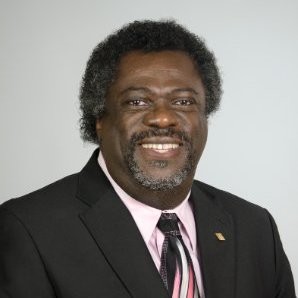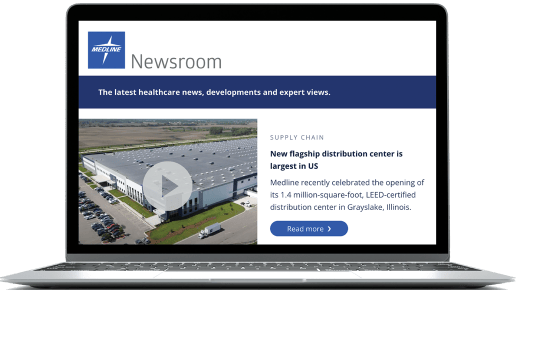The future of healthcare: 5 things nurses want and need

By Medline Newsroom Staff | May 8, 2023
Ernest Grant, PhD, RN, was one year into his tenure as president of the American Nurses Association (ANA) when the pandemic hit, launching healthcare, and the nursing profession in particular, into “a very challenging time.
“Everyone is mentally and physically exhausted from two plus years of constant care and watching people die at a rate that no one could even fathom,” said Dr. Grant, in his last interview as ANA president. And with ongoing staff shortages, nurses continue to work “double, triple, quadruple overtime shifts, and are not necessarily taking care of their own needs.
“When you’re on an airplane they say to put your own mask on first,” said Dr. Grant. “That’s something that we fail to do. As a nurse, you can’t be expected to provide care, especially to a very critically ill patient,” without enough sleep or food. And this lack of self-care, combined with extended work shifts, can increase the possibility of medication errors and other complications.
“Older nurses are ready to retire and younger nurses are saying, ‘I’m not going to do that. I want a life outside of the hospital. I do care about people, but I also care about me.’ We need to put some checks and balances into place.”

Ernest Grant, PhD, RN
Immediate Past President, American Nurses Association
While staff shortages are not new, said Dr. Grant, a nurse for more than 44 years, the extent and duration of these shortages are extraordinary. Before COVID-19, there was a deficit of approximately 120,000 nurses. Today, that number has grown to more than 500,000. And a new survey by the National Council of State Boards of Nursing found that nearly 900.000 nurses – one-fifth of the workforce – are expected to leave the profession by 2027.1
“Older nurses are ready to retire and younger nurses are saying, ‘I’m not going to do that. I want a life outside of the hospital. I do care about people, but I also care about me,’” Dr. Grant continued. “We need to put some checks and balances into place.”
Moving the profession forward post-pandemic, says Grant, will require an understanding of “the things that nurses are wanting and needing.”
Moving the profession forward
Last year, the ANA went out into the field to talk with nurses about ongoing professional challenges, and identified five priorities:
- A safe environment. “The first part of that could be making sure there’s enough staff,” said Dr. Grant. “We’re also seeing increased reports of nurses being hit by patients, family members and colleagues,” or even killed. Grant said there has always been some violence in nursing, “but never to this extent. Everyone is so tense.” Nurses need to feel supported and protected in these instances. He also said that patients should not be allowed to treat nurses “like servants.”
- Diversity, equity and inclusion. “It’s important to make sure (nurses) feel that their culture is being appreciated,” said Dr. Grant, and when there are opportunities for advancement, “that the playing field is level; that there is equity there.” It’s also important to broadly communicate job openings, so staff are well informed of opportunities.
- The opportunity to prioritize patients. Nurses want to be at the bedside instead of “checking boxes on the (electronic medical record) EMR.” However, “the way it’s looked at by the payer/administrator, if it wasn’t checked, it wasn’t done,” said Dr. Grant. As a result, nurses often are forced to choose between spending more time with a patient or loved one – even when there’s a devastating diagnosis, or loss of a family member – and administrative tasks. “Maybe we need a system in place to justify that it’s OK that this box didn’t get checked. The nurse needed to be with the patient.”
- Shorter shifts and access to mental health support. Dr. Grant says that many hospitals are looking at moving from 12 to eight-hour shifts, as “12 hours quickly turns into 13 or 14. By the time you get home, you may only get five or six hours of sleep. And then you have to go back and start over.” He also said it’s important to address “mental health fatigue,” and to ensure that mental health services are widely available to nurses, and without stigma.
- Adequate compensation and benefits. Finally, “nurses need to feel valued,” and that may differ depending on a nurse’s age or life stage, said Dr. Grant. For baby boomers, a steady income and 401(k) or pension may be the priority. Younger nurses may prioritize a portable 401(k), scheduling flexibility, and career and educational opportunities. “Active listening” is needed to determine nurse priorities. In addition to understanding why nurses are leaving an organization, “you also need to listen to that nurse who has been there five, 10 or 15 years. What keeps you here? What are the things that are good?” Those attributes can be highlighted when recruiting new nurses.
Nearly 900,000
nurses – one-fifth of the workforce – are expected to leave the profession by 20271
To maintain staffing levels, Dr. Grant says it’s important that nonclinical staff understand the value of nurses. While the chief nursing officer is advocating for more full-time positions, “he or she may not have the strings to pull. Often, it’s the (chief financial officer) CFO or (chief operating officer) COO who you really have to convince.”
Addressing staff shortages
He suggests inviting executives to shadow a nurse for a day and to “experience everything they do,” including no lunch or bathroom breaks, if that is the case on a particular day.
Too often nurses step in to cover for staffing shortages, “which becomes a pattern, and pretty soon it becomes an expectation, instead of nurses saying, ‘no, this is not safe,”’ said Dr. Grant.
In terms of recruiting more nurses to offset staff loss, Dr. Grant says there are wait lists for nursing schools, partially because there are not enough trained faculty nor available space and clinical opportunities to meet requirements and demand. Congress recently approved funding for nurse education and research; however, “it takes some time for money to free up. In the meantime, we’re still seeing a huge deficit.”
Despite the ongoing nurse staffing shortages and other challenges, Dr. Grant sees positive, long-term outcomes from the pandemic.
“I never would have thought when I started in 2019 that we would be where we are today,” said Dr. Grant, who ended his second, two-year term in December 2022. “COVID changed the trajectory, but it also sped things up. The good news is that we are now able to address these issues head on at a much faster pace than we thought possible.”
This interview was brought to you by the Medline Institute. Learn more about the healthcare leadership seminars offered through the Medline Institute .
References:
- National Council of State Boards of Nursing (April 13, 2023), NCSBN Research Projects Significant Nursing Workforce Shortages and Crisis https://www.ncsbn.org/news/ncsbn-research-projects-significant-nursing-workforce-shortages-and-crisis
Medline Newsroom Staff
Medline Newsroom Staff
Medline's newsroom staff researches and reports on the latest news and trends in healthcare.


